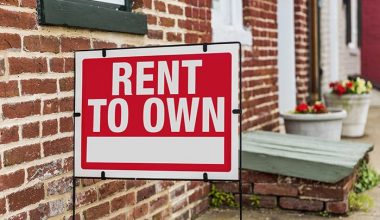There is a certain limit to almost everything, including an individual that owns real estate. As impossible as it may sound, someone other than the owner can actually place a claim against the property. This act is recognized as an encumbrance on real estate. As someone who’s into real estate, the word “encumbrance” should be familiar, but it’s okay if you’re just hearing about it for the first time because this piece would not just define encumbrance but also explain blanket encumbrance with an example to enlighten you. So, join us as we set the ball rolling
What Is an Encumbrance in Real Estate?
An encumbrance in real estate is simply a charge made against a property by someone other than the owner. It can also affect the property’s transferability and prohibit its free utilization until the impediment is removed.
Certain encumbrances have an impact on an estate’s value or commercial viability, but some don’t have such an impact. Moreover, many property owners embrace many encumbrances. Such as zoning restrictions that prohibit staying in a certain location from becoming utilized for business reasons. Others, such as liens positioned on a property to demand debt recovery, can be more onerous.
Types of Encumbrance in Real Estate
Encumbrances can address a number of financial and non-financial claims on a property. And their use can safeguard parties while also defining what each claim is all about.
#1. Easement
An easement grants an individual or persons permission to utilize the property of another owner for a certain time and for a particular purpose. Utility industries, for example, encumbrance in real estate, may obtain an easement to have accessibility to an individual’s land to repair their facilities. Alternatively, another example of encumbrance in real estate pedestrians may have the right to utilize a sidewalk that runs through that property.
#2. Legal Encumbrances
The execution of the law, such as environmental rules, produces encumbrances. However, these limits have no bearing on the sale of the land but instead on its utilization. There is a requirement for purchasers to undertake thorough research when handling legal encumbrances. In order to have a better understanding of how to utilize a property, they have an interest in buying.
#3. Lien
A lien is a form of security interest. That provides a creditor the ability to claim the assets as security for an unfulfilled commitment, most commonly an unpaid debt. Hence, the creditor can then auction the property to recuperate at least some of their loan amount.
A tax lien:
This is a lien that the government establishes to impose tax payments in the US. A federal tax lien takes precedence over all other claims on a debtor’s properties. A mechanic’s lien is a claim against an individual or real property on which the claimant has performed services. In other words, it is a lien that is put on an asset to settle a loan owing to a subcontractor for their services. Or perhaps, they give resources to repair or enhance the asset.
Here is an example of encumbrance in real estate in regards to tax lien to understand better. Suppose a contractor performed changes to your home that you never bother paying for. Judgment liens are retainable against a defendant’s properties in a case.
Lis Pendens:
This term refers to “pending legal action.” The utilization is when they embroil assets in a legal disagreement over the title or a contractual disagreement. The issuing of a lis pendens may be in a plethora of situations to prohibit the sale or disposition of ownership.
- An example of encumbrance in real estate in lis pendens is if a seller violates a purchase agreement in terms of selling to whomever, the initial buyer may file a lis pendens to halt the transaction until a court determines which bidder has the right to the transaction.
- If a successor tries to sell the property he got by inheritance, another successor can file a lis pendens to prohibit the sale until a judge determines their competence to partake in the inheritance.
- In the case of separation, a notification to issue lis pendens can be to prohibit one partner from selling an asset. Arbitrarily prior to the other spouse’s agreement and the resolution of the distribution of marital assets. This is also an example of encumbrance in real estate.
#4. Restrictive Covenants
A restrictive covenant is a commitment to perform or avoid taking a certain action on real estate. Restrictive covenants are widespread in neighborhoods that adhere to the norms of a homeowners organization. Hence, an HOA is another example of encumbrance in real estate in restrictive covenants. An HOA may mandate a home to satisfy specific upkeep criteria, such as regular grass trimming or house cleaning.
#5. Lease
A lease is an agreement to rent a specific property for a set period of time at a set price. A lease confers rights on the leaseholder that ain’t affected by the purchase of the rental asset. It is a legal right to use the land in a specific way that it cannot take it away by a subsequent owner.
#6. Mortgage
One of the most prevalent sorts of security interest is a mortgage. It is basically a lien against real estate assets. Until the mortgage is cleared, the lender, usually a financial institution, has a share in the ownership of the house. If the debtor defaults on the mortgage by not paying. The creditor may foreclose, seizing the property as security and evicting the occupants.
#7. Encumbrance of Deed Restrictions
In certain circumstances, private landowners restrict or prohibit the use of their property for specific purposes. Such restrictions remain in place even after the property is in the hands of heirs or in the hands of the new owners. It is critical to determine if any restrictions have been imposed on the asset in this regard. This is particularly imperative in the case of vast plots of land that are in subdivisions and sell it as individual chunks.
Blanket Encumbrance in Real Estate
You can define a blanket encumbrance in real estate as a mortgage or trust deed. It encompasses more than one parcel of real estate and frequently an entire subdivision. Selling of particular lots is typical with half due to some technicality from the blanket encumbrance in real estate mortgages.
In a simplified way, you can also define blanket encumbrance in real estate as an agreement that influences more than one parcel by which the subdivider retains the subdivision under an alternative.
The Legal Definition of “Blanket Encumbrance”
The word “blanket encumbrance” in legal real estate refers to a trust deed, mortgage, judgment, or any other lien. A blanket encumbrance in real estate affects a subdivision or impacts more than one property offered within a subdivision, along with an option or contract for sale or a trust arrangement.
How to Know if a Property Is an Encumbrance
The best approach to find out if a property has encumbrances is to conduct a title search and purchase title insurance. These strategies can also safeguard a homeowner from any loss in property value if an undetected encumbrance is discovered on their land.
A property title search, in greater detail, is a check of a property’s public documents to authenticate the property’s lawful rightful owner. And also to check for any complaints or limitations that may arise. Following the completion of a title search, a homeowner can obtain title insurance to safeguard against specific claims or problems in the title to a property.
Should I Avoid Buying an Encumbrance Property?
Nearly all assets are an encumbrance in some fashion, especially in rapidly growing areas.
If you’re considering not buying from an encumbered property. Then you should spend some time understanding more about the encumbrance and don’t just be concerned about the limits. Before you avoid buying from a property, it is far more vital to understand the encumbrance and ensure that it will not infringe on your pleasure of the asset.
But, there are some major encumbrances to be mindful of since they may get to be the obligation of the current buyer if not resolved prior to closing.
Encumbrances vs Liens
A lien is a financial claim against a property in order to achieve payment—the settling of a debt from the owner of the property. An encumbrance is a considerably broader term that you can define to be any type of claim against real estate. In short, you can define an encumbrance in real estate, or rather it is any lien, although not all liens are encumbrances.
Liens
A lien is a lawful entitlement provided to a lender by the landowner of a property, through a statute, or by other means. A lien is for ensuring an underlying commitment, such as debt repayment. If the underlying commitment is not met, the lender may be ready to take the asset covered by the lien.
Liens are mostly a monetary incentive. A lien is usually the outcome of a lawsuit filed by a lender. It basically grants the lender the right to confiscate and auction the asset against which the lender has a lien in order to meet the remaining loans. An obvious case: if an individual fails to fulfill payments on an auto loan, the finance company may seize and sell the vehicle to get payment. Liens can also include the ability to seize funds from the debtor’s bank account.
Tax liens are liens that are attached by taxing authorities. A federal tax lien is distinguished by the fact that it takes precedence over all other lenders’ claims.
Encumbrance
You can define an encumbrance as a claim against real estate by someone other than the owner. An encumbrance can impact the property’s transferability and impede its free use.
Encumbrances are not always monetary in nature; they can also involve land-use restrictions or easements. Any interest in the asset that affects or decreases the asset’s worth or clear title is an encumbrance.
An easement is a real estate term that describes a situation in which one party utilizes the asset of another party in exchange for a fee given to the property’s owner in exchange for the right of easement. Easements tend to buy by public utility providers in exchange for the right to install telephone poles or conduct pipelines above or under personal land.
Although payments are made to the property owner, easements can have a detrimental impact on property values. Unsightly electricity lines, for instance, can detract from the visual attraction of a plot of land.
Things to Consider
Liens and encumbrances are most frequently connected with real estate, however, either can apply to personal property. If a person fails to pay a debt, a lender or a tax authority may impose a lien or an encumbrance on the person’s property. Possessing such a claim against the property generates an uncertain title and may impede the property’s capacity to be sold or otherwise transferred.
Any current encumbrance must be notified to possible customers by the property’s owner. When a buyer purchases a property, he or she inherits the encumbrance. If a seller fails to disclose current encumbrances, the buyer may take legal action against him.
What Is the Purpose of Encumbrance?
Encumbrance accounting’s primary goal and advantage are to prevent budget overspending by including open obligations in anticipated expenses. The amount of funds available as a tool for expected spending planning is affected by encumbrances.
Can You Sell a Property With Encumbrance?
Even when a debt is currently tied to a piece of property, the owner can still legally sell it (loan). Most of the time, the buyer even benefits from this. Due to the owners’ acute financial need, those who sell in circumstances like this typically do so at significantly cheaper prices.
What Are Encumbrances on Title?
A claim made against a piece of property by someone who isn’t the owner is called an encumbrance. The transferability of the property and its freedom of use may be impacted by encumbrances. Encumbrances can also be easements or restrictions on how a property is used; they are not always financial.
How Do I Remove Encumbrances of the Title?
The Register of Deeds where the property is located must receive a petition for cancellation of encumbrance submitted in accordance with Section 4, Rule 74 of the Rules of Court. Keep in mind that failing to wait the required two years before filing the petition will result in its denial.
Is a Lien the Same as an Encumbrance?
A lien is a legitimate right or interest that a creditor has in someone else’s property that typically lasts until the debt or obligation is paid. A claim or liability affixed to the property is referred to as an encumbrance. Any property right that is not a right of ownership is included. One kind of encumbrance is a lien.
Are Encumbrances Free?
It has no liens, private caveats, or other encumbrances that would prevent the transfer of the title. If the title is charged to your bank, don’t be concerned; it will be discharged as part of the sale procedure.
Are Encumbrances an Expense?
An encumbrance is projected and not yet a fact, just like the budget itself. The burden will turn into an expense if business conditions stay the same as when you set the budget. However, circumstances could alter throughout the course of a year or during the time frame specified by the budget.
Conclusion
To refresh your mind, an encumbrance is a charge or claim against a property by someone other than the owner. It can also affect the property’s transferability and prohibit its free utilization until the removal of the impediment.
Certain encumbrances have an impact on an estate’s value or commercial viability, but some don’t have such an impact. Moreover, property owners embrace many encumbrances, such as zoning restrictions that prohibit dwellings in a certain location from becoming utilized for business reasons. Others, such as liens positioned on a property to demand debt recovery, can be more onerous.
ENCUMBRANCE IN REAL ESTATE FAQ
What is the purpose of an encumbrance in goverment?
The purpose and the usage of encumbrance are commonly in governmental accounting to assure that there will be enough cash to cover particular obligations.
What is an encumbrance in finance?
Encumbrance in finance describes the constraints that accounting systems apply to avoid excess spending. For a firm to spend money or makes a purchase, encumbrances identify the aim of the cash.
How do I remove encumbrances?
By completely paying off a mortgage or deed of trust, that’s when the removal of the encumbrance from the property will take place. Plus deleting it from the public records. A “reconveyance deed,” which provides the owner of the property with a clear title, is a frequent document for the removal of an encumbrance.
- SPECIAL WARRANTY DEED: Definition & How It Works (Texas & Florida)
- HOW MANY MORTGAGES CAN YOU HAVE: REAL ESTATE INVESTING
- 1% Rule Real Estate: Definition & What it is
- TAX LIEN SALE: +Guide for Lien Sale Cars
- What Is a Lien on a House: Is it Bad to Have a Lien on Your House
- REAL ESTATE AGENT VS BROKER: What’s the Difference?






